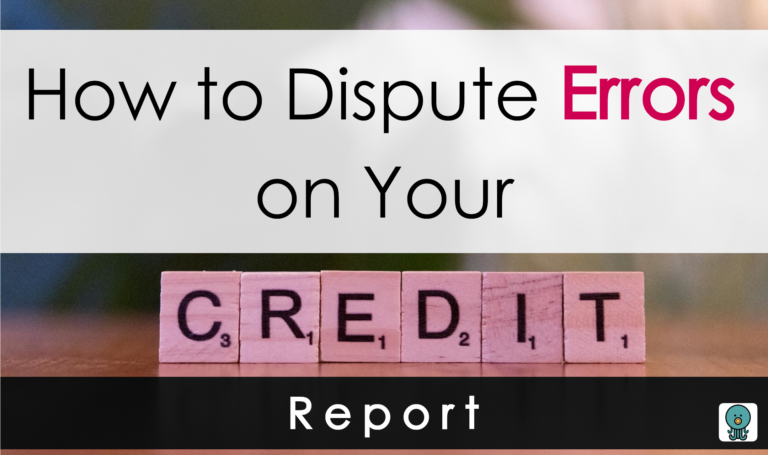Your credit report is like the referee of your financial game—it calls the shots on your credit score, loan approvals, and even job applications. But what happens when the referee makes a bad call? Errors on your credit report, like incorrect late payments or accounts that don’t belong to you, can tank your score and cost you big time. The good news? You have the power to challenge those errors and set the record straight. Disputing errors on your credit report isn’t just smart—it’s your right under federal law.
In this guide, we’ll walk you through the step-by-step playbook for disputing errors on your credit report, from spotting mistakes to submitting disputes and following up. We’ll also share pro tips, sample letters, and resources to help you win the game. Whether you’re tackling a small typo or a major mix-up, this article will equip you to take control of your credit—and maybe even enjoy the process. Let’s kick things off!
Why Disputing Credit Report Errors Matters
Before we dive into the how-to, let’s talk about why disputing errors on your credit report is a big deal. Think of your credit report as your financial report card—it’s used by lenders, landlords, employers, and even insurers to judge your reliability. Errors in this report can lead to:
- Lower Credit Scores: Mistakes like a false late payment can drop your score by dozens of points, making loans and credit cards harder to get.
- Higher Interest Rates: A lower score means higher interest rates, costing you thousands over the life of a loan.
- Loan Denials: Errors can lead to rejected applications for mortgages, car loans, or credit cards.
- Job or Housing Issues: Some employers and landlords check credit reports, and errors could hurt your chances.
Under the Fair Credit Reporting Act (FCRA), you have the right to dispute inaccurate information on your credit report, and credit bureaus are legally required to investigate. Fixing errors can boost your score, save you money, and open doors to better financial opportunities. Ready to take action? Let’s break it down.
Also Read: Cash Back Vs Travel Rewards: Which One Is Better For You In 2025?
Step-by-Step Guide to Disputing Errors on Your Credit Report
Disputing errors on your credit report is a straightforward process, but it requires precision and persistence. Follow these steps to challenge inaccuracies and get your credit back on track.
Step 1: Get Your Credit Reports
The first move is to get your hands on your credit reports from the three major credit bureaus: Equifax, Experian, and TransUnion. Each bureau may have different information, so you need to check all three to spot errors.
How to Get Your Credit Reports
| Method | Description |
| AnnualCreditReport.com | Free weekly credit reports from all three bureaus, authorized by federal law. |
| Credit Bureau Websites | Visit Equifax.com, Experian.com, or TransUnion.com for additional free reports. |
| Mail or Phone | Request reports by mail or phone using instructions on AnnualCreditReport.com. |
Pro Tip: As of 2025, you can access free weekly credit reports indefinitely through AnnualCreditReport.com, thanks to updates during the COVID-19 pandemic. Take advantage of this to monitor your credit regularly.
Keyword Tip: Search for “free credit reports AnnualCreditReport.com” or “how to get credit reports for free” to find guides and updates.
Step 2: Spot the Errors
Once you have your reports, it’s time to play detective. Review each report line by line to identify errors. Common mistakes include:
| Type of Error | Description |
| Personal Information | Wrong name, address, Social Security number, or birthdate. |
| Account Errors | Accounts that don’t belong to you, duplicate accounts, or incorrect balances. |
| Payment History | False late payments, missed payments, or incorrect payment dates. |
| Collections | Debt collections you don’t owe or that were already paid. |
| Inquiries | Unauthorized hard inquiries from lenders or creditors. |
| Public Records | Inaccurate bankruptcies, judgments, or liens (rare, as most were removed in 2018). |
Pro Tip: Use a highlighter or spreadsheet to track errors across all three reports. Note the bureau, section, and specific details of each mistake.
Step 3: Gather Evidence
To win your dispute, you need solid evidence—like a star player bringing receipts to the game. Collect documents that support your claim, such as:
| Evidence Type | Examples |
| Payment Records | Bank statements, canceled checks, or payment confirmations. |
| Account Statements | Credit card or loan statements showing correct balances or payments. |
| Correspondence | Letters or emails from creditors confirming account status or errors. |
| Identity Documents | Driver’s license, Social Security card, or utility bills to correct personal info. |
| Police Reports | For identity theft or fraudulent accounts, include a police or FTC report. |
Pro Tip: Organize your evidence in a folder or digital file, labeled by error and bureau, to keep your dispute airtight.
External Resource: For identity theft cases, file an identity theft report with the Federal Trade Commission (FTC) at IdentityTheft.gov to strengthen your dispute.
Step 4: File Your Dispute
Now it’s time to take the field and file your dispute with the credit bureaus. You can dispute errors online, by mail, or by phone, but mail is often the most effective for complex disputes because it provides a paper trail.
Sample Dispute Letter Template
Here’s a sample letter to get you started. Customize it with your details and evidence:
[Your Name]
[Your Address]
[City, State, ZIP Code]
[Date]
[Credit Bureau Name]
[Credit Bureau Address]
[City, State, ZIP Code]
Subject: Dispute of Inaccurate Information on Credit Report – [Your Full Name, Last 4 Digits of SSN]
Dear [Credit Bureau Name], I am writing to dispute the following inaccurate information on my credit report, pursuant to the Fair Credit Reporting Act. Please investigate and correct these errors: 1. [Describe Error #1, e.g., “Account #123456 with XYZ Bank is listed as 30 days late on 01/15/2025. This is incorrect, as I made the payment on time, as shown in the attached bank statement.”] 2. [Describe Error #2, if applicable, with details and evidence.] Enclosed, please find copies of supporting documentation, including [list evidence, e.g., bank statements, payment confirmations]. I request that you correct or remove the inaccurate information and send me an updated credit report. Thank you for your attention to this matter. Please contact me at [your phone number] or [your email] if you need additional information.
Sincerely,
[Your Full Name]
[Your Signature, if mailing a physical letter]
Pro Tip: Send your dispute via certified mail with a return receipt requested to confirm delivery. Keep copies of everything you send.
External Resource: The Consumer Financial Protection Bureau (CFPB) offers sample dispute letters and filing tips at CFPB.gov.
Step 5: Dispute with the Creditor (If Needed)
If the error stems from a creditor or lender (e.g., a bank reporting a false late payment), you should also dispute the error directly with them. Creditors are required to investigate and report corrections to the credit bureaus under the FCRA.
How to Dispute with a Creditor
| Step | Description |
| Gather Evidence | Use the same evidence you sent to the credit bureau. |
| Contact the Creditor | Call or write to the creditor’s customer service or dispute department (contact info on your statements or their website). |
| Send a Dispute Letter | Similar to the credit bureau letter, outline the error, include evidence, and request correction. |
Pro Tip: Keep a log of all communications with creditors, including dates, names of representatives, and outcomes, in case you need to escalate the issue.
Step 6: Follow Up
After filing your dispute, the credit bureaus have 30 days (or 45 days in some cases) to investigate and respond, as required by the FCRA. Creditors typically have the same timeline. Here’s what to do while you wait:
What to Expect
| Action | Description |
| Acknowledgment | The bureau or creditor will confirm receipt of your dispute, often with a case number. |
| Investigation | The bureau contacts the creditor or data furnisher to verify the information. |
| Resolution | You’ll receive a written response with the investigation results and an updated credit report, if changes are made. |
Pro Tip: If you filed online, use the bureau’s dispute portal to track your case. If you sent a letter, watch for a response in the mail and check your credit reports again to confirm corrections.
Step 7: Escalate If Necessary
If the credit bureau or creditor denies your dispute or fails to correct the error, don’t throw in the towel. You have options to escalate the issue:
Escalation Options
| Option | Description |
| File a Complaint | Submit a complaint to the CFPB at CFPB.gov or the FTC at FTC.gov. |
| Add a Statement | If the error can’t be removed, add a 100-word statement of dispute to your credit report, explaining your side. |
| Hire an Attorney | For serious errors or violations of the FCRA, consult a consumer law attorney. You may be entitled to damages. |
| Monitor Your Credit | Use free credit monitoring services to watch for new errors or fraud. |
Pro Tip: If the error involves identity theft, consider placing a fraud alert or credit freeze on your reports to prevent further damage. Learn more at IdentityTheft.gov.
External Resource: For legal help, contact the National Association of Consumer Advocates (NACA) at ConsumerAdvocates.org to find an attorney specializing in credit reporting issues.
Also Read: How to Solve Cash Flow Problems in Small Businesses
Common Credit Report Errors to Watch For
To help you spot errors quickly, here’s a rundown of the most common mistakes on credit reports, based on CFPB and FTC data:
| Error Type | Frequency (Approx.) | Impact on Credit Score |
| Incorrect Personal Info | 20% of disputes | Minimal, but may signal identity theft |
| Wrong Account Status | 30% of disputes | Moderate to severe, depending on error |
| False Late Payments | 25% of disputes | Severe, up to 100+ points drop |
| Fraudulent Accounts | 15% of disputes | Severe, up to 100+ points drop |
| Unauthorized Inquiries | 10% of disputes | Moderate, 5-10 points per inquiry |
Pro Tip: According to a 2023 FTC study, about 1 in 5 consumers have an error on at least one of their credit reports, so regular checks are a must.
Tips for Disputing Credit Report Errors Like a Pro
Disputing errors can feel like a game of chess—strategy matters. Here are some pro tips to give you the upper hand:
- Check Reports Regularly: Use free weekly reports from AnnualCreditReport.com to catch errors early.
- Be Specific: Clearly describe each error in your dispute, including account numbers, dates, and evidence.
- Keep Records: Maintain a file of all dispute letters, responses, and evidence for at least seven years (the FCRA statute of limitations).
- Use Certified Mail: For mailed disputes, certified mail ensures proof of delivery and receipt.
- Monitor Your Score: Use free credit score tools like Credit Karma or Experian to track changes after disputes are resolved.
- Stay Persistent: If your dispute is denied, don’t give up—escalate the issue or seek legal advice if needed.
External Resource: For more tips and tools, check out the FTC’s credit repair guide at FTC.gov under “Credit and Loans.”
When to Seek Professional Help
Disputing errors on your own is often effective, but some situations call for reinforcements. Consider professional help if:
- Errors Are Complex: Multiple errors across all three bureaus or disputes involving legal issues.
- Identity Theft Is Involved: Fraudulent accounts or widespread identity theft require expert intervention.
- Disputes Are Denied: If bureaus or creditors refuse to correct errors, a lawyer can help enforce your FCRA rights.
- Time Is Limited: If you don’t have time to manage the dispute process, a credit repair service or attorney can step in.
Pro Tip: Be cautious with credit repair companies—some charge high fees for services you can do yourself. Always check reviews and verify legitimacy through the Better Business Bureau (BBB) at BBB.org.
FAQ
Q: How do I dispute errors on my credit report for free?
A: Use AnnualCreditReport.com to get free credit reports, then file disputes online, by mail, or by phone with the credit bureaus (Equifax, Experian, TransUnion). Include evidence and track your case—all at no cost.
Q: How long does it take to dispute errors on a credit report?
A: Credit bureaus have 30 days to investigate and respond (45 days in some cases). Complex disputes or escalations may take longer, so stay persistent.
Q: What evidence do I need to dispute credit report errors?
A: Gather payment records, account statements, correspondence, identity documents, or police reports (for fraud). The more evidence, the stronger your case.
Q: Can disputing credit report errors hurt my credit score?
A: No, filing a dispute doesn’t impact your score. In fact, correcting errors can boost your score, especially if the error was severe, like a false late payment.
Q: What if the credit bureau denies my dispute?
A: Escalate the issue by filing a complaint with the CFPB or FTC, adding a statement of dispute to your report, or consulting a consumer law attorney.
Q: How often should I check my credit reports for errors?
A: Check all three reports at least once a year, or weekly using free reports from AnnualCreditReport.com, to catch errors early and prevent damage.
Q: Is it worth hiring a credit repair company to dispute errors?
A: It depends. For simple disputes, you can do it yourself for free. For complex issues or identity theft, a reputable credit repair service or attorney may be worth the cost—just vet them carefully.
The Verdict
Disputing errors on your credit report is like calling a timeout in a high-stakes game—it gives you the chance to fix bad calls and get back on track. Following this step-by-step guide has helped you spot errors, gather evidence, file disputes, and follow-up with confidence. Whether you’re tackling a small typo or a major fraud issue, the process is within your reach—and the payoff can be huge, from better loan terms to higher credit scores.
Your credit report is your financial playbook, and you’re the coach. So, grab your reports, roll up your sleeves, and start disputing those errors today. You’ve got this—and your financial future will thank you!





